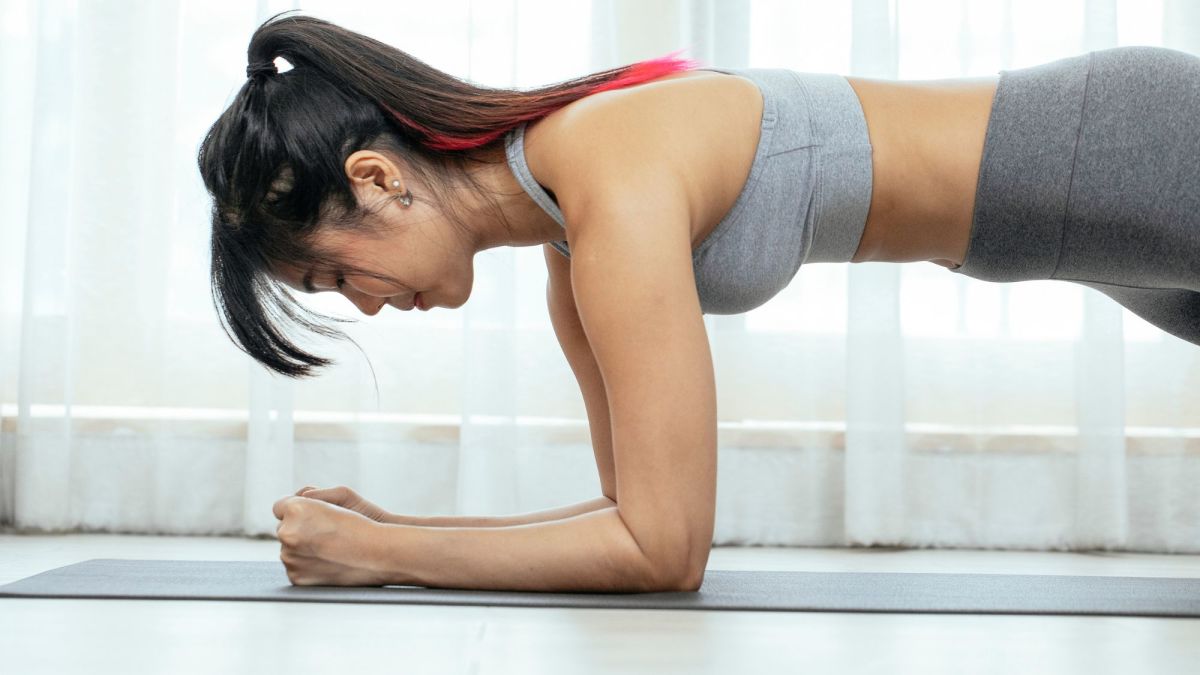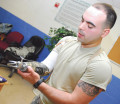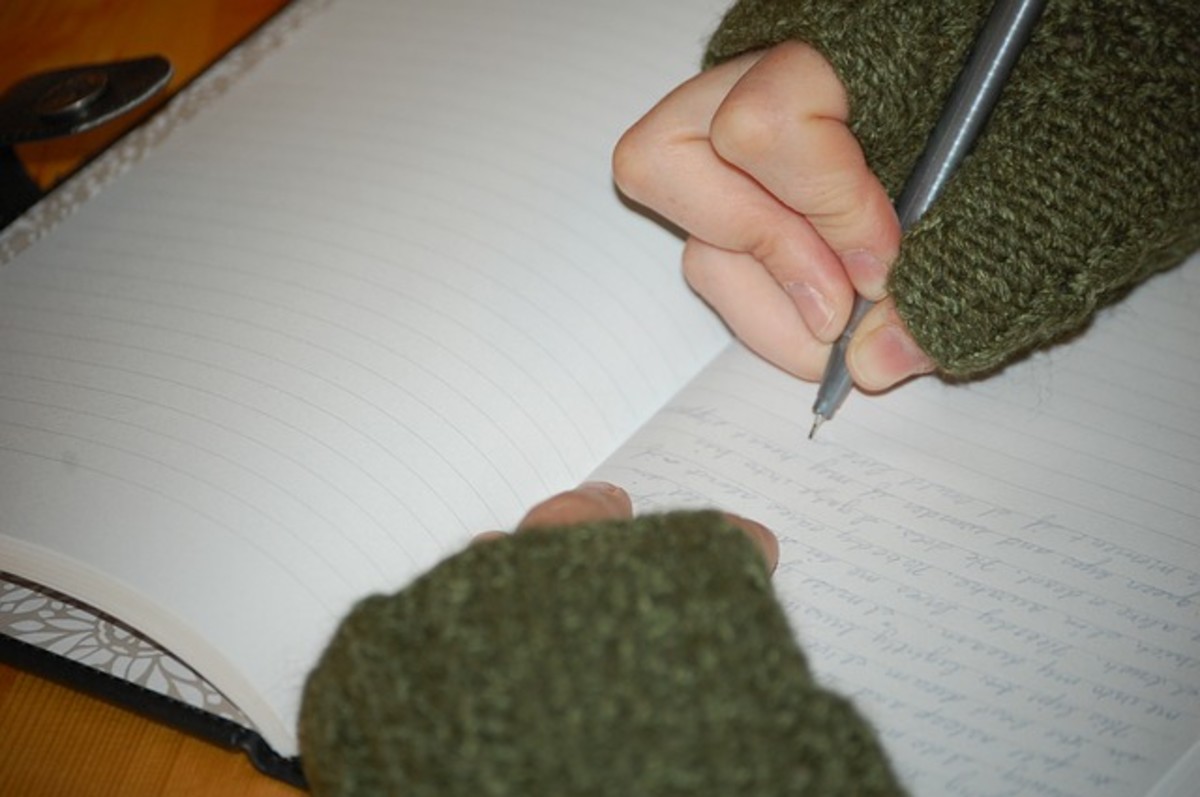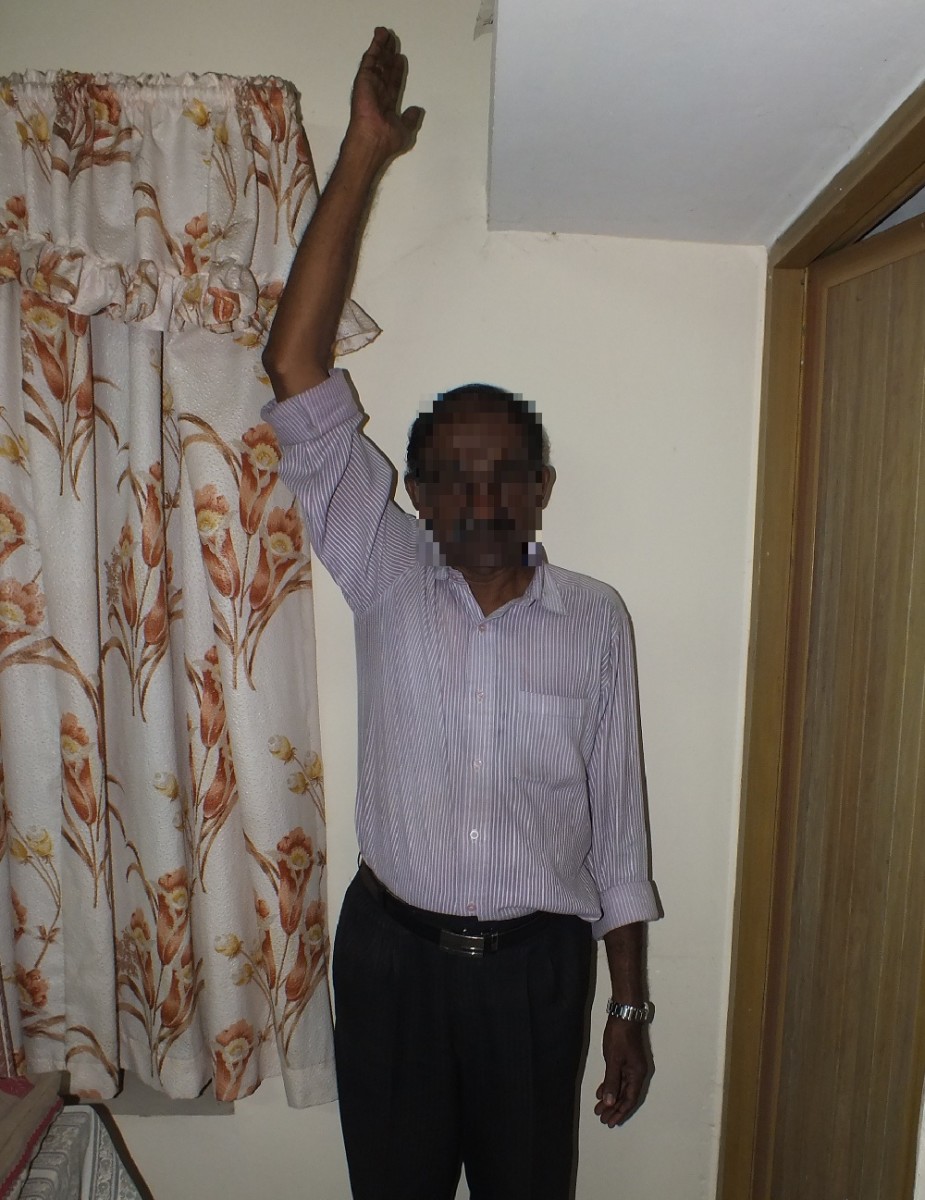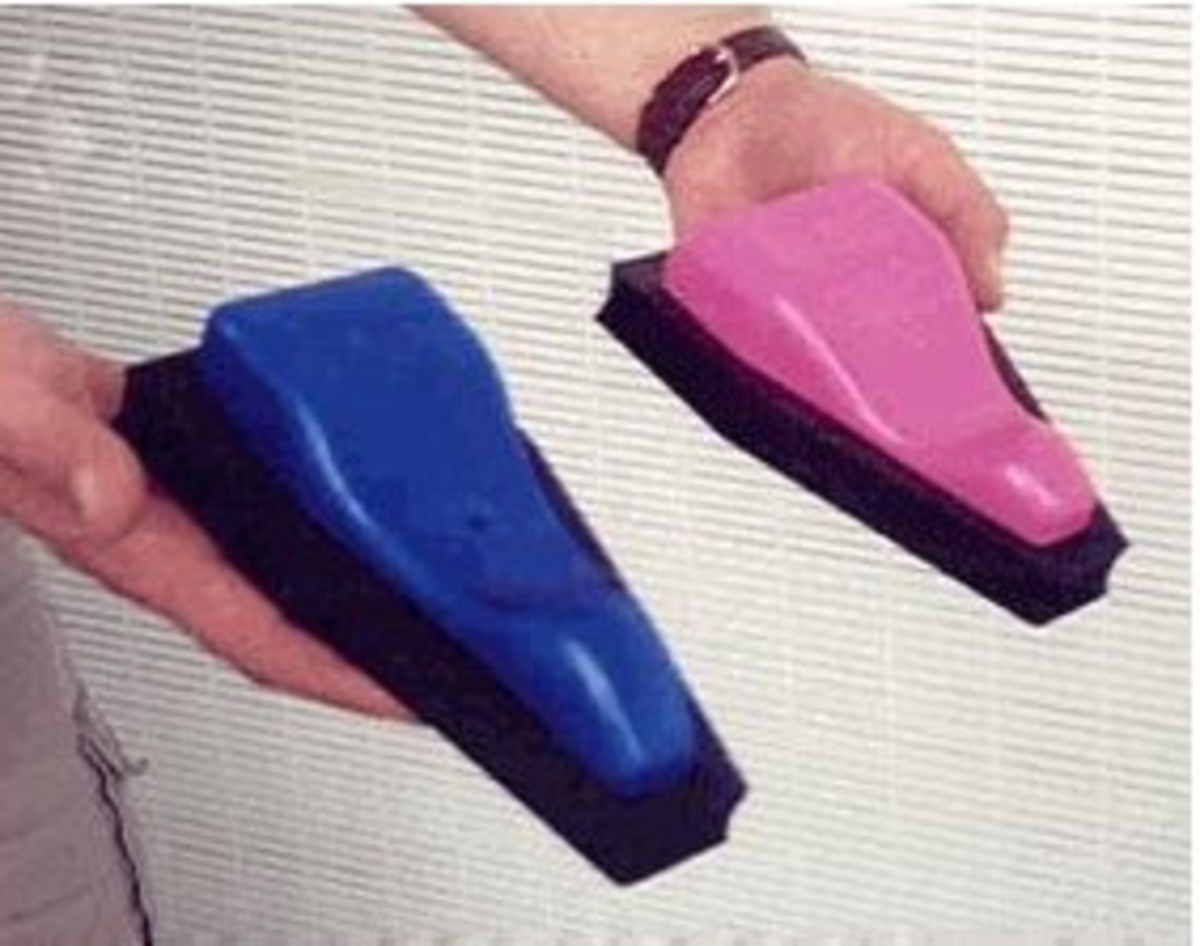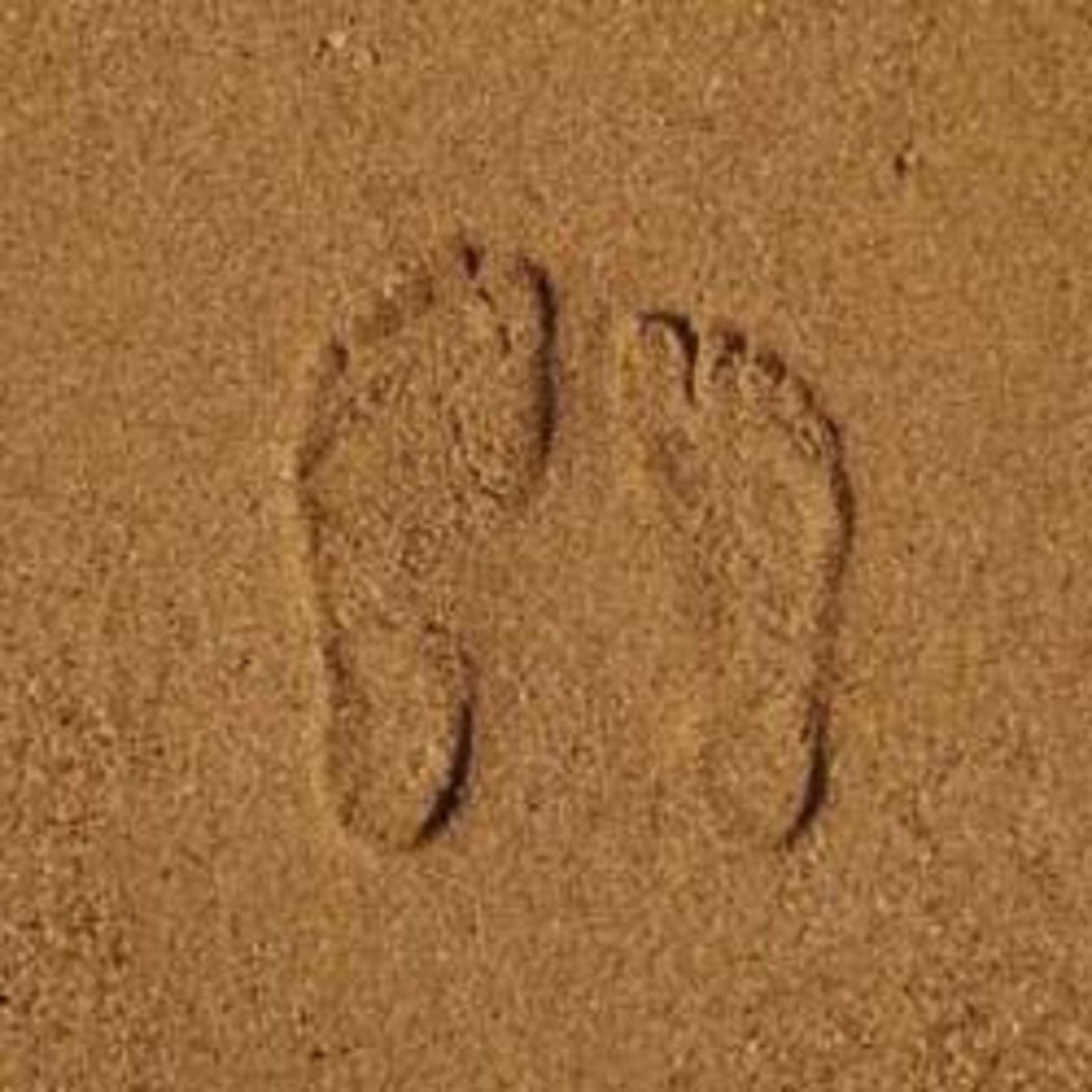Tennis Elbow – Physiotherapy Treatment #3
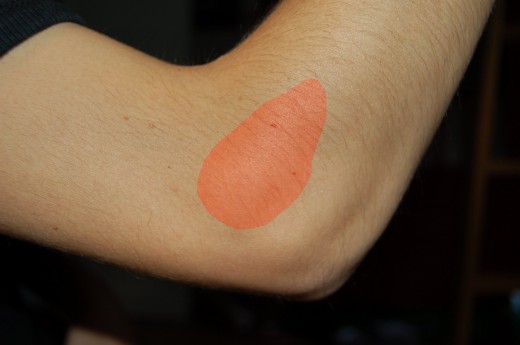
Introduction
Once the acute stage has subsided, exercise programme for the elbow as well as for the wrist is indicated. To start with, active and carefully guided passive range of motion exercises to the elbow are advisable. The exercises may be slowly and gradually progressed to stretching exercises. When such exercises are attempted, they must be done within the limits of severe pain. If painful movements are attempted, they may adversely affect the already injured or damaged Common Extensor Tendon or the site of its attachment. In such cases we cannot expect the co-operation of the patient which is essential for carrying out the physiotherapy treatment successfully. Active and carefully guided passive range of motion exercises are beneficial as they maintain the range of motion of the elbow joint as they stretch the muscles, the tendons, the ligaments, the fascia and the joint capsule around the elbow joint. Moreover they maintain the tone of the muscles of the forearm. They also reduces the muscular spasm and hence the pain. To start with the exercises must be done in small amplitudes. The amplitude of the exercises may be increased gradually. The exercises may be more effective if they are done after the application of ice or heat (Please refer my earlier article on ‘Tennis Elbow’.)
In this article I would like to discuss some exercises that may help to relieve the symptoms of ‘Tennis Elbow.’ Before resorting to the exercise programme, an advice from a qualified physiotherapist may be sought. The therapist must examine the patient thoroughly to find out the exact condition of the patient.
The patient may have the following problems which are to be dealt with in addition to pain.
- Limitation of range of motion of elbow joint due to the contracture of the soft tissues around the elbow joint.
- Limitation of range of motion of the joints of the forearm (upper and lower radio-ulnar joints) restricting inward rotation (pronation) or/and outward rotation (supination) of the forearm.
- Muscular Spasm is increased and hence the pain.
- Weakness of the muscles of the forearm especially the extensor group of muscles (muscles on the back side of the forearm).
Hence only a thorough examination and evaluation of the involved upper limb by a physiotherapist can bring out the actual problems which are to be dealt with. Hence he may be able to advice and chart out the correct regime of exercises which are suitable for a particular given patient.
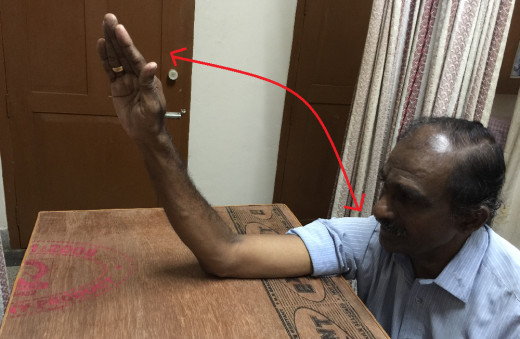
1. Active Exercise 1
Let the patient has Right Tennis Elbow.
The patient sits on a small stool near a table facing it, in such a way that the height of the table is almost in line with the shoulder joint of the patient. Now the patient keeps his right upper limb on the table so that the right elbow rests on it. Now supinate the right forearm (hold the forearm and the hand inwards) bend the right elbow slowly and gently with the fingers extended and try to touch the front of the right shoulder joint with the finger tips. It should be done within the limits of severe pain. Hold in that position for 2 seconds. Pronate the right forearm (turn and hold the forearm and the hand outwards) and straighten the right elbow slowly and gently with the fingers extended and try to touch the surface of the table with the palmar aspect (front side) of the hand. It should be done within the limits of severe pain. Hold in that position for 2 seconds. Repeat the exercise 10 times thrice a day. To start with, do the exercise in small amplitudes and then progressed to larger amplitudes.
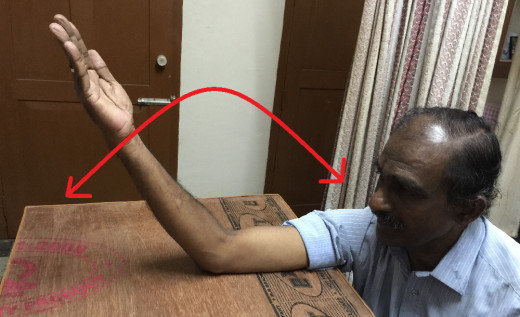
2. Active Exercise 2
Let the patient has Right Tennis Elbow.
The patient sits on a stool near a table facing it, in such a way that the height of the table is almost in line with the shoulder joint of the patient. Now the patient keeps his right upper limb on the table so that the right elbow rests on it. Now supinate the right forearm (hold the forearm and the hand inwards) bend the right elbow slowly and gently with the fingers extended and try to touch the front of the right shoulder with the finger tips. It should be done within the limit of severe pain. Hold in that position for 2 seconds. Now straighten the right elbow slowly and gently with the forearm and the hand still in the supinated position with the fingers extended. Now try to touch the surface of the table with the dorsal aspect (back side) of the hand. It should be done within the limits of severe pain. Hold in that position for 2 seconds. Repeat the exercise 10 times thrice a day. To start with, do the exercise in small amplitudes and then progressed to larger amplitudes.

3. Active Exercise 3
Let the patient has Right Tennis Elbow
The patient sits at the edge of a table or bed with the legs hanging down and the right hand resting on the bed. The patient flexes (bends) the right wrist and keeps the dorsal aspect of the right hand on the bed with the fingers kept straightened. In this position, the right elbow is usually in a flexed (bend) position. Now straighten the right elbow with the dorsal aspect of the right hand still in contact with the bed and the fingers still in extension. Now a stretch is felt along the extensor aspect (back side) of the right forearm. Avoid severe stain to the wrist. Hold on to the stretched position. Now flex (bend) the fingers of the right hand and try to touch the palmar aspect of the right hand with the finger tips, so that a maximum stretch is felt along the extensor aspect (back side) of the right forearm. Hold in the maximum stretched position for 3 seconds. Now slowly and gently return back to the starting position. Repeat the exercise 10 times, thrice a day. While doing the exercise, avoid severe pain.
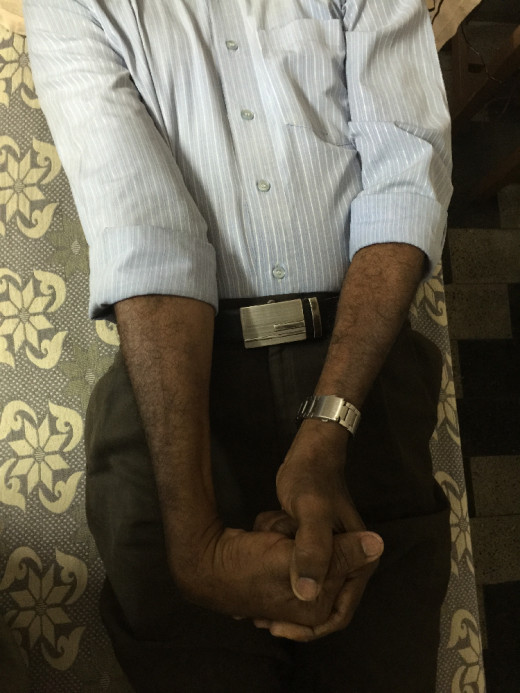
4. Active Exercise 4
Let the patient has Right Tennis Elbow.
The patient lies supine (lying with the face upwards) with the upper limbs extended and kept by his sides. Make a ‘fist’ with the right hand and flex (bend) the wrist. Now a stretch is felt along the extensor aspect (back side) of the right forearm. Hold on to the stretched position. Avoid severe strain to the wrist. Now hold the dorsal aspect (back side) of the right hand which is kept flexed at the wrist with the left hand in such a way that the right ‘fist’ lies within the left hand. Now flex (bend) the right wrist further with the left hand so that a maximum stretch is felt along the extensor aspect (back side) of the right forearm. Avoid severe strain to the wrist. Hold in the maximum stretched position for 3 seconds. Now slowly and gently return back to the starting position. Repeat the exercise 10 times, thrice a day. While doing the exercise, avoid severe pain.
The same exercise can be done in the standing position also.
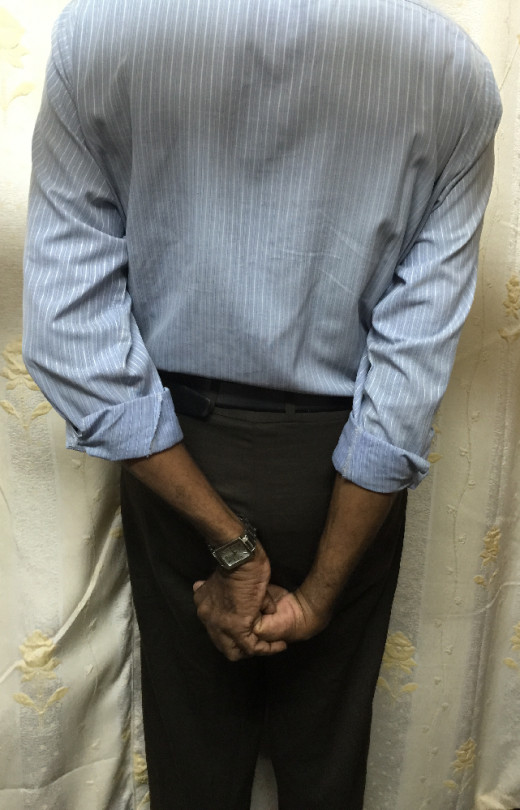
5. Active Exercise 5
Let the patient has Right Tennis Elbow.
The patient stands relaxed with the feet apart and the upper limbs hanging down. Bring the extended right upper limb towards the back and is held in the midline in such a way that the right hand is at the level of the buttocks. Make a ‘fist’ with the right hand and flex (bend) the right wrist. Now a stretch is felt along the extensor aspect (back side) of the right forearm. Hold on to the stretched position. Avoid severe strain to the wrist. Now hold the dorsal aspect (back side) of the right hand which is kept flexed at the wrist with the left hand in such a way that the right ‘fist’ lies within the left hand. Now flex (bend) the right wrist further with the left hand so that a maximum stretch is felt along the extensor aspect (back side) of the right forearm. Avoid severe strain to the wrist. Hold in the maximum stretched position for 3 seconds. Now slowly and gently return back to the starting position. Repeat the exercise 10 times, thrice a day. While doing the exercise, avoid severe pain.
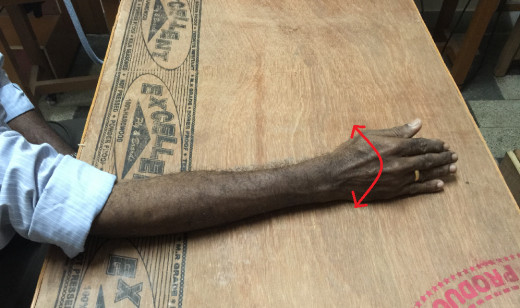
6. Active Exercise 6
Let the patient has Right Tennis Elbow.
The patient sits on a chair near a table facing it. He keeps his bend right elbow and the forearm on the table in such a way that the ulnar border (inner side) of the right forearm rests on the table. The fingers are held in extension. Now he supinates (turning upwards) the right forearm till a stretch is felt along the anterior surface (front side) of the right forearm. Now the forearm and the hand face upwards. Hold in this stretched position for 2 seconds. Now return back to the starting position. Now he pronates (turning downwards) the right forearm till a stretch is felt along the posterior aspect (back side) of the right forearm. Now the right forearm and the right hand face downward. Hold in the stretched position for 2 seconds. Now slowly and gently return back to the starting position. Repeat the exercise 10 times, thrice a day.
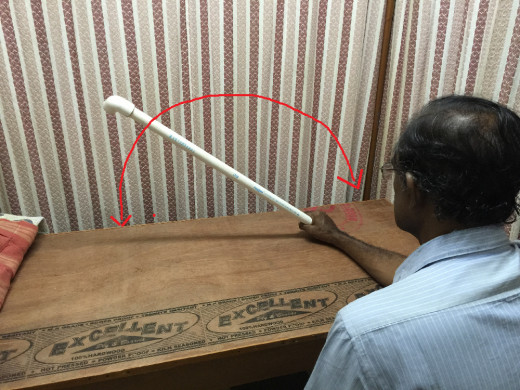
7. Active Exercise 7
Let the patient has Right Tennis Elbow.
The patient sits on a chair near a table facing it. He keeps his bend right elbow and the right forearm on the table in such a way that the ulnar border (inner side) of the right forearm rests on the table. He holds a stick at its one end in such a way that the stick points vertically upwards. Now he supinates (turning upwards) the right forearm with the stick still in his hand till a stretch is felt along the anterior surface (front side) of the right forearm. Now the right forearm faces upwards. Hold in the stretched position for 2 seconds. Now return back to the starting position. Now he pronates (turning downwards) the right forearm with the stick still in his hands till a stretch is felt along the posterior aspect (back side) of the right forearm. Now the right forearm faces downwards. Hold in the stretched position for 2 seconds. Return back to the starting position. Repeat the exercise 10 times, thrice a day.
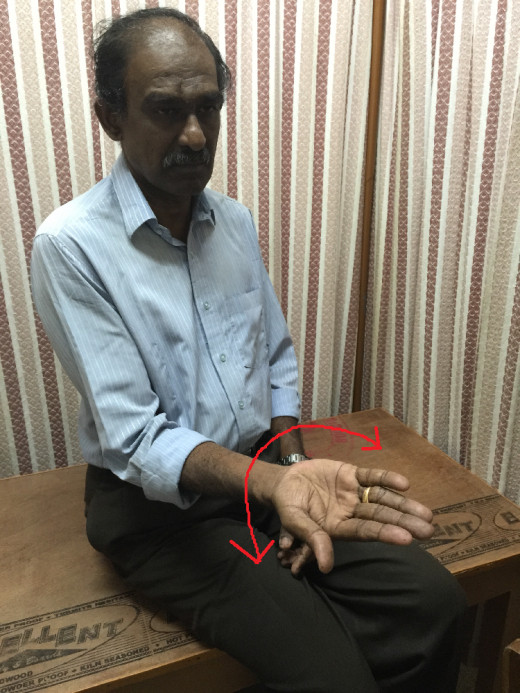
8. Active Exercise 8
Let the patient has Right Tennis Elbow.
The patient sits on a chair with the upper limbs hanging down. The right elbow is flexed to 90 degrees with the ulnar border (inner side) of the right forearm facing downwards with the fingers extended. The right upper arm must be held close to the body. Now he supinates (turning upward) the right forearm till a stretch is felt along the anterior (front side) of the right forearm. Now the right forearm and the right hand face upwards. Hold in the stretched position for 2 seconds. Return back to the starting position. Now he pronates (turning downward) the right forearm till a stretch is felt along the posterior aspect (back side) of the right forearm. Now the right forearm and the right hand face downwards. Hold in the stretched position for 2 seconds. Return back to the starting position. Repeat the exercise 10 times, thrice a day.
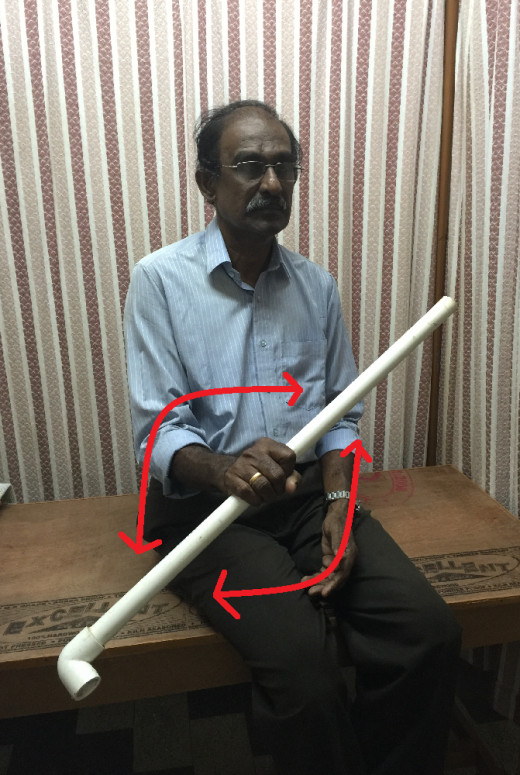
9. Active Exercise 9
Let the patient has Right Tennis Elbow.
The patient sits on a chair with the upper limbs hanging down. The right elbow is flexed to 90 degrees with the ulnar border (inner side) of the right forearm facing downwards with the fingers extended. The right upper arm must be held close to the body. He holds a stick at its middle with the right hand in such a way that the stick points vertically upwards. Now he supinates (turning upward) the right forearm with the stick still in his hand till a stretch is felt along the anterior surface (front side) of the right forearm. Now the right forearm faces upwards. Hold in the stretched position for 2 seconds. Return back to the starting position. Now he pronates (turning downward) the right forearm with the stick still in his hands till a stretch is felt along the posterior aspect (back side) of the right forearm. Now the right forearm faces downwards. Hold in stretched position for 2 seconds. Return back to the starting position. Repeat the exercise 10 times, thrice a day.
10. Active Exercise 10-Strengthening Exercise 1
Let the patient has Right Tennis Elbow.
The patient sits on a chair in front of a table facing it. The patient keeps his bend right elbow on the table in such a way that the elbow is bend approximately 45 degrees and the palmar aspect of the right hand is facing downwards with the fingers extended. Let the right wrist is extended (lifting the right hand upwards) approximately to 90 degrees with the fingers still in extension. Lift up the right hand further with the fingers still in extension till the maximum upward range is attained. Hold the wrist in the maximum attained position for 2 seconds. Slowly and gently return back to the starting position. Repeat the exercise 10 times, thrice a day.
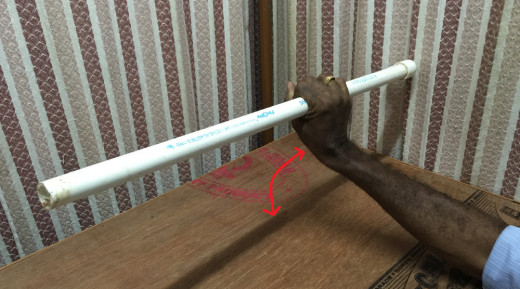
11. Active Exercise 11-Strengthening Exercise 2
Let the patient has Right Tennis Elbow.
The patient sits on a chair in front of a table facing it. The patient keeps his bend right elbow on the table in such a way that the elbow is bend approximately 45 degrees and the palmar aspect of the right hand is facing downwards with the fingers extended. Let the right wrist is flexed (bend) approximately to 90 degrees with the fingers still in extension. Now the patient holds a stick at its middle with his right hand in such a way that the stick is horizontal and almost parallel to the floor. Now he slowly and gently lifts up the right wrist along with the stick which is held in his hand till the maximum upward range is attained. Hold the right wrist in the maximum attained upward position for 2 seconds. Return back to the starting position. Repeat the exercise 10 times, thrice a day. The weight of the stick must be such that it’s lifting up must not cause much strain to the wrist.
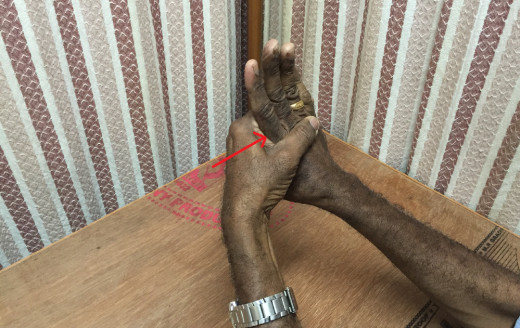
12. Active Exercise 12 –Strengthening Exercise 3
Let the patient has Right Tennis Elbow
The patient sits on a chair near a table facing it. The patient keeps his right elbow on the table in such a way that the elbow is flexed (bend) approximately to 45 degrees and the palmar aspect of the right hand is facing downwards with the fingers extended (straight). Now flex (bend) the wrist to 90 degrees with the fingers still in extension. Now the patient holds the right hand with his left hand in such a way that the fingers of the left hand lies on the palmar aspect (front side) of the right hand and the left thumb lies on the dorsal aspect (back side) of the right hand. Now the patient lifts up the right hand with the right fingers still in extension to which a minimum resistance is offered by the left hand. The resistance offered by the left hand must be slow, gradual and gentle so that it does not cause any discomfort to the right wrist. Hold the right wrist in the maximum attained upward position for 2 seconds. Return back to the starting position. Repeat the exercise 10 times, thrice a day. As a progression, the resistance may be increased in a graded manner.
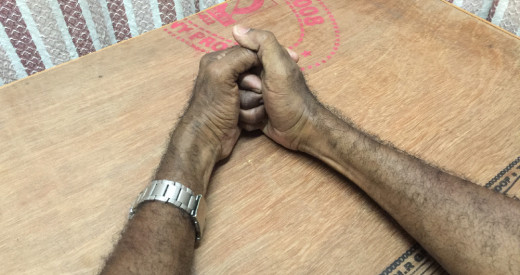
13. Active Exercise 13-Strengthening Exercise 4
Let the patient has Right Tennis Elbow.
The patient sits on a chair near a table facing it. He keeps his bend right elbow and the right forearm in such a way that the ulnar border (inner side) of the right forearm rests on the table, with the fingers extended. Now make a ‘fist’ with the right hand and flex the right wrist to 90 degrees. Now hold the dorsal aspect (outer side) of the right hand and the fingers which are still held in flexion with the left hand in such a way that the right ‘fist’ lies within the left hand. The patient lifts up the right wrist and straighten the fingers, to which a minimum resistance is offered by the left hand. The resistance offered by the left hand must be slow, gradual and gentle so that it does not cause any discomfort to the right wrist. Hold the right wrist and the fingers to the maximum attained upward position for 2 seconds. Return back to the starting position. Repeat the exercise 5 times, thrice a day. As a progression, the resistance may be increased in a graded manner.

